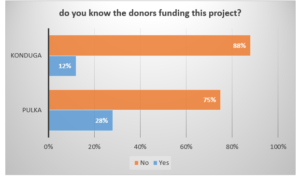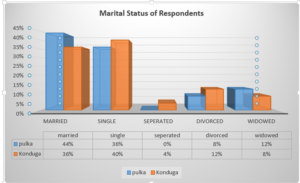1.0 Project Overview
In Borno state today given the protracted nature of the crisis coupled with limited access to basic services, most women residing in IDP camps and host communities endure domestic violence, including physical and sexual assault, and often remain with their husbands as a result of cultural beliefs that dictate submissive behavior for women. According to the UNHCR End Year Report of 2017 on Sexual and Gender Based Violence (SGBV), other forms of SGBV, such as child marriage are prevalent in all camps and there tends to be a common response to such violence. Elders and community leaders prefer using the Sharia Law rather than the formal judicial system to address SGBV incidents, even in areas where a formal judicial system is in place. As a result, justice is delivered by agreement between the perpetrator and survivor’s family.
It is on record by UNHRC that from January to December 2017, a total number of 1,639 survivors and those at risk of SGBV were referred to access specialized services including psychosocial counseling, medical care, legal and safety and security services.
Understanding that the emergence of Boko Haram insurgency has brought Sexual and gender-based violence to the fore as one of the major manifestations of the crisis in North-East Nigeria. It is seen in adoption, rapes, suicide bombers, domestic violence, etc.
This project will intensify the mobilization of women, youth, and girls’ groups as well as other CSOs for advocacy and awareness on prevention, monitoring/reporting, response, and care for survivors while using the dignity kits as an entry point to all the interventions. The strategy of identifying women’s groups at the state and local community level builds their capacity to understand the strategy of share knowledge, networking, partner, and jointly advocate for EVAWG, GEWE, and ending VAWG and SRHR in Borno state. Also, this project will identify and get referrals from other actors list of GBV survivors that will be enrolled in informed micro income skill acquisition training, for them to be independent. This project will contribute to Outcome 5 and 6 as our actions will contribute to support and strength of women’s groups in Borno state as well as women and girls’ safety, security, and human rights. Also, local and state dialogue with both government and traditional leaders will be held and commitment will be made.
We will address VAWG causes through: empowering girls with knowledge of rights and support to demand change and engaging community members (community leaders, men, boys) in tackling gender inequality (social norms). Girls and boys will be mobilized as change agents and IGA will reduce girls’ economic dependency. Women/Girls groups will be trained in VAWG and SRHR, share learning, and undertake collective advocacy for policy gaps to be addressed.
1.2 Main Goal of the Project
Women’s rights groups, autonomous social movements, and relevant civil society organizations, including those representing youth and groups facing intersecting forms of discrimination/marginalization, more effectively influence and advance progress on GEWE and EVAWG, including SGBV/HPand Women and girl’s safety, security and human rights are enhanced
.
1.3 Objectives of the Project
The specific objectives are:
Women’s rights groups and relevant civil society organizations representing groups facing intersecting forms of discrimination/marginalization have strengthened capacities and support to design, implement and monitor programs and policies on VAWG, including SGBV/HP, and
1.4 Purpose and Objective of the Post-Distribution Monitoring
The post-distribution monitoring is aimed at providing information on the efficiency and effectiveness of the programme activity, for internal accountability and learning which will be used for designing, planning and implementation of future programmes and for accountability to donors.
Specific objectives are:
-
- To assess the impact of IGAs on beneficiaries and to learn and apply recommendations to support affected women and girls to better manage fund.
-
- To determine the extent to which the activity has improve the lives of vulnerable women and girls.
2.0 Survey Methodology
A quantitative study design was adopted for the evaluation. The method incorporates the use of quantitative result-based approach which brought the perspectives of IGA beneficiaries of project activities together to assess the process and short-term impact of the activity. Project’s result proposal, activity concept note, project log frame all served as a survey guiding document. Household survey techniques was used in which questionnaire were designed, cleaned and analyzed using pivot table to categories responses.
3.0 Social and Demographic information of respondents
3.1 Respondents Geographical Distribution
The study covered 12 communities across 2 LGAs (Konduga LGA and Pulka in Gwoza LGA) of Borno State including Internally Displaced Persons Camps (IDPs) and Host communities. A total of 50 respondents were reached across the 12 communities of project implementation.
3.2 Demographic Profile of Respondents
3.2.1 Marital distribution of Respondents in
Pulka
Findings reveal that most of the respondents representing 44% are married, 36% are single who are basically youths aged 18 -35years. 0% are separated, 12% are widowed while 8% are divorced.
Konduga
Findings reveal that most of the respondents representing 36% are married, 40% are single who are basically youths aged 18 -35years. 4% are separated, 8% are widowed while 12% are divorced.
Figure 2: Marital distribution of respondents
3.2.3 Age distribution of respondents
Findings revealed that the age range 0-12 years represents 12% of the population of the respondents, age range 13-17 represent 28% of the respondents compared to adults aged 18 to 59 and above years which represents 60% of the respondents in Pulka. While in Konduga Findings revealed that the age range 0-12 years represents 4% of the population of the respondents, age range 13-17 represent 44% of the respondents compared to adults aged 18 to 59 and above years which represents 52% of the respondents. Considering the vulnerabilities of women to conflict and violence, the activity was targeted only on women
Figure 3: shows the age distribution of respondents.

3.3 How Beneficiaries were selected and enrolled into the initiative.
Findings revealed that all of the respondents were selected and referred by LETSAI’s Partners GSWA and were confirmed and enrolled by LETSAI’S field staff. 100% percent were enrolled by LETSAI’s field staff, which means 0% of the respondents were enrolled by any other means.
Figure 5: how survivors were selected and enrolled as beneficiaries

Findings revealed that all of the respondents in Pulka and Konduga representing 100% of the respondents were informed of the viable business options available in their community.
Figure 6: Were you informed of the shortlisted and viable business
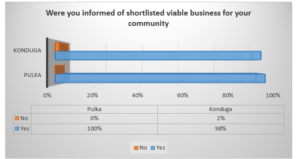
Findings also revealed that all of the respondents in Pulka and Konduga representing 100% selected their business within the viable business options in their community.
Figure 7: Did you select your business within the viable business options in your community

3.4 Perception of Beneficiaries on the selection processes of beneficiaries of IGA
Findings from the study revealed that all of the respondents (100%) in Konduga and Pulka received what they selected prior to distribution. The study revealed that all sampled participants that benefited from the startup kit are satisfied with the business they selected and the entire selection process. Also, they did not give anything in exchange for the startup Kits distributed.
Figure 8: Received item selected?
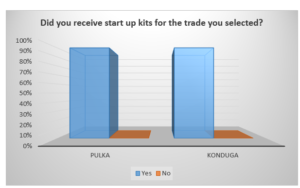
3.5 Quality and Set up of the start up kits distributed to Beneficiaries.
Quality of Kits: Findings revealed that 100% of the respondents from both locations are satisfied with the quality of the startup kits they received, but they were probed further to rate the quality of the startup kits of the in Pulka 88% of the respondents rated the quality of business start-up kits as excellent, 11% as very good and 1% rated the quality of kits distributed as fair, while in Konduga 91% of the respondents rated the quality of business start-up kits as excellent, 9% as very good and 0% rated the quality of kits distributed as fair. As revealed, most of the respondents rated the quality of business start-up kits as very excellent, this implies that the quality is good enough to achieve the outcome of the initiative.
The Content of Start-up Kits: Findings from the study revealed that 100% of the beneficiaries from both locations stated that no item was missing in the start-up kit given to them
.Figure 9: Quality of the startup kit?

Figure 10: Was anything missing?
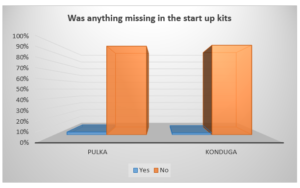
3.7 Use of the IGA startup kits Items received and Outcome of the use of items received.
Use of IGA Items: Findings from the study revealed that 91% of the total respondents use the IGA start up kits items received for their intended business purpose.
Outcome of Item Use: The survey revealed that in Pulka 90% of the respondents made profit from the business they started with the IGA startup kits item received, this is due to our community mobilizers hands on approach, they conducted daily follow ups just to deter the beneficiaries from selling the startup kits. while 6% of the respondents sold the kits and 4% consumed the items received with family members while in Konduga 83% of the respondents made profit from the business they started with the IGA startup kits item received while 12% percent of the beneficiaries sold the kits and 5% consumed the items received with family members
Figure 11: What did you do with the Startup kit received.
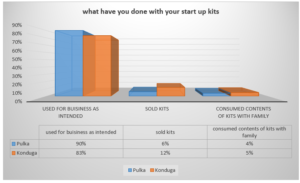
Figure 12: Have you made any profit so far?
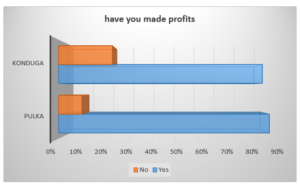
3.8 Economic and Livelihood Wellbeing of beneficiaries
Survey findings reveals that 92% of the Respondents in Pulka surveyed have experienced positive changes in their livelihood and economic wellbeing, while 8% did not experience any change either because they sold the start up kits or consumed it while in Konduga 90% of the respondents surveyed have experienced positive change while 10% haven’t. Most of the respondents who reported changes in wellbeing can now save money, afford basic medical needs and other essential items of personnel hygiene for self and children, and can also afford better shelter and clothing.
Figure 13: Have you experienced any positive change?
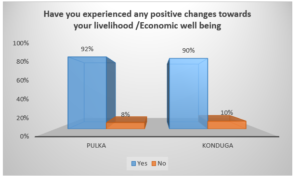
3.9 COMMUNITY RESPONSE MECHANISM
Findings reveal that 100% of the respondents in both locations are aware of the complaints and feedback channel put in place for this particular project, there are volunteers on ground to record and report complaints from the beneficiaries on ground when the need arises, so far 5 complaints has been recorded from beneficiaries from both locations, which have been handled accordingly.
Figure 14: complaints and feedback channel.

Findings from our respondents reveal that in pulka 100% which is 25 of the respondents are satisfied with how their complaints is being handled and addressed while in Konduga 92% which is 23 of the respondents are satisfied with how their complaints is being addressed and handled while 8% which is 2 respondents are not satisfied which is largely due to issues not being reported through the proper channel which in this instance is the community volunteers.
Figure 15: CRM effectiveness
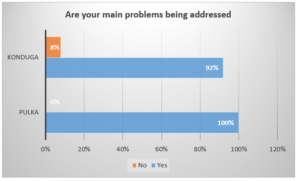
findings reveal that in pulka 92% which is 23 of the respondents are so far satisfied and with the services rendered and the process that went along with it, but 8% which is 2 of the respondents in pulka were not impressed and feel the organization can do better in addressing their issues, while in Konduga 84% which is 21 respondents are really impressed and satisfied with services provided by the organization but 12% which is 4 respondents were not satisfied with the overall performance of the organization.
Figure 16: organizational rating
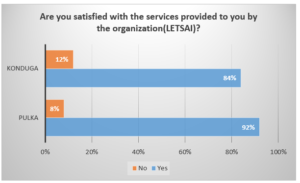
4.0 VSLA MONITORING
The village savings and loan association was set up to help the beneficiaries attain some level of financial freedom
and independence, survey with respondents in Pulka reveals that 97% of the respondents found the VSLA to be very helpful and efficient, while 3% of the respondents don’t find it helpful. While in Konduga 91% of the respondents found the VSLA to be very helpful and efficient while 9% of the respondent didn’t.
Figure 17: Do you find the VSLA helpful?
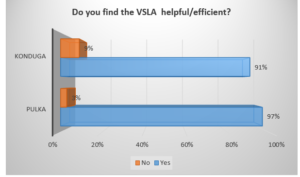
4.1 Attendance Frequency
Survey findings in Pulka reveals that 98% of the respondents have at a point attended the VSLA meeting with other association members while 2% of the respondents have never attended a meeting of the association. While in
Konduga 90% of the respondents have at one point attended the VSLA meeting while 10% of the respondents have never attended a meeting.
Figure 18: Attendance frequency
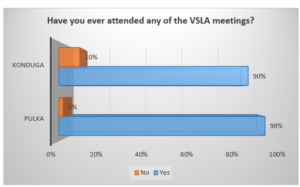
4.2 profit margins
Survey findings in Pulka reveals that respondents who started up business shows 63% are able to make profits of
1000 naira and more weekly while 37% of the respondents make less than 1000 naira weekly while in Konduga findings shows that 71% of the respondents make less than 1000 naira weekly as profits while 29% of the respondents make more than 1000 naira weekly as profits.
Figure 19: Weekly profit margins

Findings in Pulka shows that 93% of the respondents surveyed deposits more than 500 naira weekly from the profits gained while 7% of the respondents deposits less than 500 naira from profits gained from the week’s activity.
While in Konduga 88% of the respondents deposits 500 naira and more to the association while 12% of the respondents deposits less than 500 naira weekly to the association.
Figure 20: Weekly Deposit to VSLA

Findings in Konduga reveals that 89% of the respondents are familiar with the use of the handbook in the association while 11% of the respondents are not fully familiar with the use of the handbook while in Pulka 97% of the respondents are familiar with the use of the associations passbook while 3% of the respondents are not fully aware.
Figure 21: use of the handbook
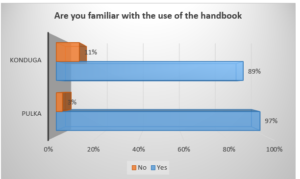
4.3 Leadership and running of association
Findings in Konduga reveals that 93% of the respondents are satisfied with the leadership and running of the association while 7% of the respondents have reservations on the leadership and how the association is being run, findings in Pulka shows that 99% of the respondents are satisfied with the leadership and the running of the association while a microscopic 1% of the respondents are not yet satisfied with the running and leadership of the association.
Figure 22: Leadership and running of association.
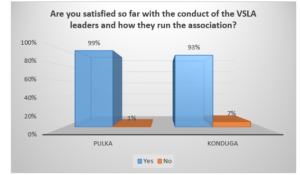
4.4 suggestions from respondents
Findings from survey reveals that when asked “What further support would you want to get from LETSAI?” 90% of respondents in Pulka suggested the provision of financial support and 10% suggested the provision of more IGA trainings and start up kits while in Konduga 98% of the respondents suggested provision of financial support while 2% suggested the provision of more IGA trainings and start up kits.
Figure 23: suggestion from Respondents
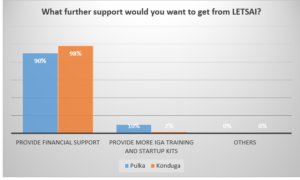
4.5 Staff Review by Respondents
Findings reveals that in Pulka 100% of the respondents think that the staff of LETSAI conducted themselves appropriately and professionally during and after training and distribution, while in Konduga 97% of the respondents are satisfied with the conduct of the staff while 3% of the respondents are not satisfied with the conduct of the staff
Figure 24: Staff review by respondents.

Findings reveal that only 12% which is 3 of the respondents know the donors of this project while in pulka only 28% which is 7 respondents know the donors funding the project.
Figure 25: Do you know th donors finding this project ?
